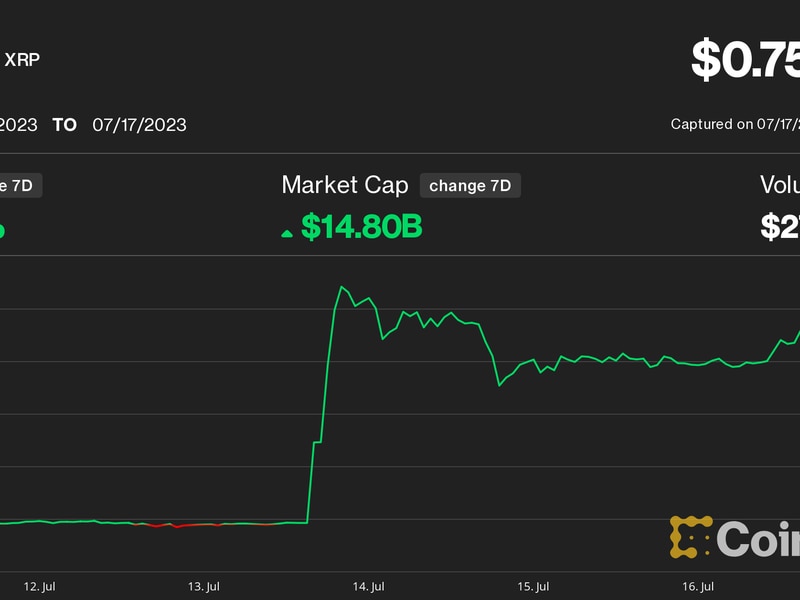First Mover: Bitcoin Cash’s Halving Was Dull – Bitcoin’s May Be Much the Same
First Mover: Bitcoin Cash’s Halving Was Dull – Bitcoin’s May Be Much the Same
Bitcoin’s upcoming halving – a once-every-four-years reduction in the supply of new units of the cryptocurrency – has got traders, analysts and gawkers abuzz over the potential price impact.
German bank BayernLB predicted last year that bitcoin’s halving could drive its price to $90,000, roughly 12 times the current level.
Cryptocurrency markets got a sneak preview on Wednesday as a lesser coin, bitcoin cash, went through its own halving. Spoiler alert: There wasn’t much to see.
You’re reading First Mover, CoinDesk’s daily markets newsletter. Assembled by the CoinDesk Markets Team, First Mover starts your day with the most up-to-date sentiment around crypto markets, which of course never close, putting in context every wild swing in bitcoin and more. We follow the money so you don’t have to. You can subscribe here.
“All in all, this has been very anticlimactic,” Denis Vinokourov, head of research at Bequant, a cryptocurrency exchange and institutional brokerage, wrote in an email.
Bitcoin cash prices rose 5.9 percent Wednesday, entirely in line with its trading range on most days. Cryptocurrencies have been volatile since long before the coronavirus hit. Bitcoin climbed 2.3 percent on the day.
“In crypto, that’s normal,” Roger Ver, executive chairman of Bitcoin.com and a key proponent of bitcoin cash, said in an audio interview over Telegram from his home in St. Kitts.

Ver says he hadn’t been expecting much from the event. He’s been around the crypto industry since the early days, and witnessed bitcoin’s halvings in 2012 and 2016. This week’s halving was the first for bitcoin cash, which split off from bitcoin in 2017.
“A leap year happens every four years,” Ver said. “Life goes on. Nobody cares. After you’ve been through one leap year, it’s not interesting or exciting anymore.”
The episode offers a dose of reality for crypto-industry newcomers who might be looking forward to something spectacular when bitcoin’s next halving arrives in May. It’s so hotly anticipated that clever web designers have erected pages featuring countdown clocks. As of the latest look, it’ll take place in an estimated 34 days, seven hours and 47 minutes. (On May 13, around 09:25 UTC.)

If bitcoin cash’s halving is any guide, there really won’t be much to see. Maybe champagne glasses will clink somewhere, celebrating the passage of another four years of bitcoin’s remarkable existence since it was created in early 2009 atop what is now the world’s largest blockchain network.
Bitcoin’s price, currently around $7,300, has climbed 20-fold since the start of 2015, the first full year of historical data from the popular cryptocurrency exchange Coinbase. There were a lot of days between then and now, many of them up, many of them down, and only one of those days in 2016 coincided with a halving.
Blockchains like the ones powering bitcoin and bitcoin cash rely on high-speed computer operators and data centers known as “miners,” which collectively process quintillions of computations per second in an effort to maintain and protect the security and integrity of the network. To keep the miners affixed over the long term, according to Ver, “the price only has to double once every four years.”
“I’ve always said that the price is the least interesting thing about cryptocurrencies,” Ver said. “The price is just a side effect of the amount of adoption you’re getting in the world.”
Four years is quite a span – enough to frustrate investors, analysts and researchers who might prefer to clearly quantify the price impact of past halvings, or of the upcoming halving.
Just think back to how much has happened in cryptocurrency markets in the past six months: Chinese President Xi Jinping said the world’s largest economy would “seize the opportunities” afforded by blockchain technology. (Bitcoin jumped 12 percent.) The U.S. killed a top Iranian general, threatening to escalate into a war. (Up 10 percent.) The coronavirus came along. (Bitcoin plunged, then recovered, and is now up 2 percent year-to-date.)
“The market’s always pricing in everything,” Ver said.
With many investors seeing bitcoin as a potential hedge against inflation – a digital and more portable form of gold, as it were – the unprecedented trillions of dollars of coronavirus-related aid and stimulus might ultimately make the halving an afterthought. Unlike the coronavirus, after all, the halving was telegraphed years in advance.
Blockware Solutions, which brokers high-speed computers used for cryptocurrency mining, wrote Wednesday in an e-mail that price is “not just supply side economics,” but demand.
“Bitcoin has the most robust ecosystem in the blockchain industry, and the fundamentals continuously improve due to the global macro improving sentiment and accelerating demand,” according to the note. The point was that bitcoin watchers shouldn’t draw too many conclusions from bitcoin cash’s halving.
Rich Rosenblum, a former managing director of Wall Street firm Goldman Sachs who now oversees markets at the digital-asset trading firm GSR, noted that bitcoin cash prices usually trade in sync with bitcoin’s – similar to the way gold and silver prices track, as do oil and gasoline.
“The bitcoin halving in a month is going to have more impact on bitcoin cash than the bitcoin cash halving,” he said in a phone interview.
Bitcoin cash’s halving took place at 12:19 UTC, when the blockchain network reached block number 630,000.
The most immediate impact was also, perhaps, the most visible: The next data block took nearly two hours to close, well beyond the average of about 10 minutes.

According to Ver, that probably happened because miners reallocated their computational power toward suddenly more profitable blockchains like Bitcoin and Bitcoin SV.
The Bitcoin Cash protocol has a feature that automatically adjusts the difficulty of mining a new data block when there’s a sudden scarcity of miners; the mechanism is designed to lure some back. Block 630,001 took just 16 minutes to close, the data show.
Just like adding an extra day to the calendar every four years, these halvings have to happen to make everything work right.
So when bitcoin’s halving comes, will it be time to pop the champagne? Why not. Will it be entertaining? Better have YouTube queued up, just in case.
Tweet of the day

Bitcoin Watch
BTC: Price: $7,327 (BPI) | 24-Hr High: $7,399 | 24-Hr Low: $7,210

Trend: Bitcoin has found acceptance above the three-day 200-candle average and looks set to extend the ongoing rally toward $8,000. That would bring prices back to a level seen ahead of the massive sell-off on March 12.
The cryptocurrency is changing hands near $7,312 at press time, while the long-term average is now located at $7,093. As seen on the three-day chart, the bulls repeatedly failed to keep gains above the crucial average in the three weeks to April 5, before flipping the hurdle into support during in the last few days.
The breakout may prompt more buyers to join the market, leading to stronger price gains. Supporting the bullish case is the three-day chart MACD histogram’s crossover above zero, a confirmation of bearish-to-bullish trend change.
The bullish case would be neutralized if the spot price drops below $7,050, violating the ascending trendline connecting the March 13 and March 30 lows.
First Mover is CoinDesk’s daily markets newsletter. You can subscribe here.
Disclosure Read More
The leader in blockchain news, CoinDesk is a media outlet that strives for the highest journalistic standards and abides by a strict set of editorial policies. CoinDesk is an independent operating subsidiary of Digital Currency Group, which invests in cryptocurrencies and blockchain startups.









